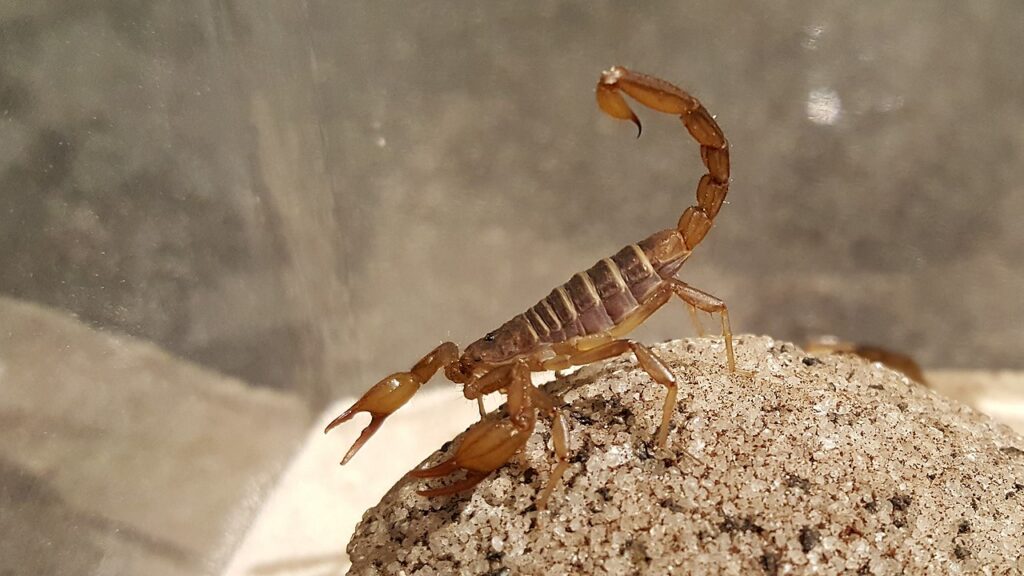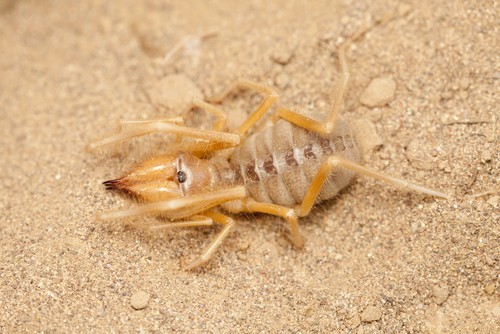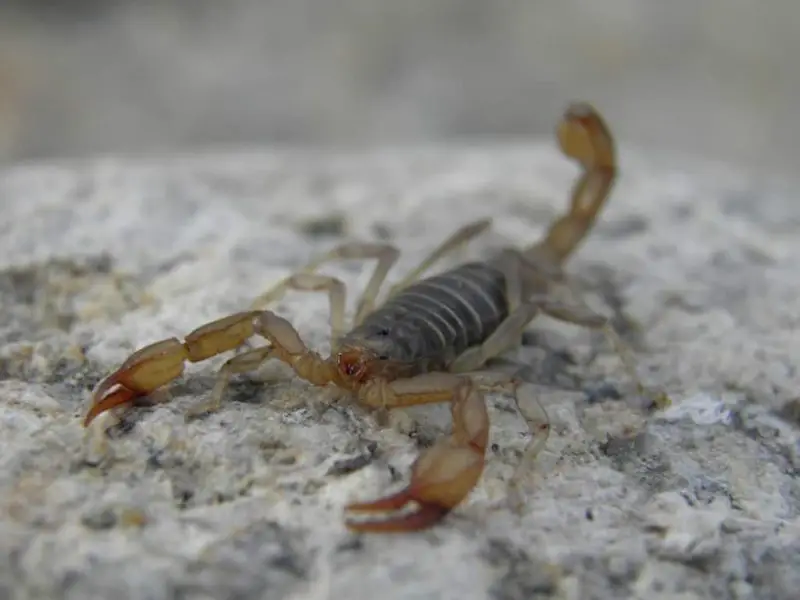When you think of Montana, elk, grizzly bears, black bears, mountain goats, and all the diverse array of native wildlife that is common to the northern rocky mountain region probably comes to mind. You probably don’t think of scorpions which are more readily associated with the sandy deserts of North America, Africa, and Asia. Nevertheless, the Big Sky State does have one scorpion species. According to the Montana field guide, of the 90 or so different species of scorpions in the United States, the only one that lives in the state of Montana is the Northern Scorpion.
There are also a couple of scorpion-like arachnids that live within Montana’s borders. These are the pseudoscorpion and the wind scorpion. In the paragraphs below, we’ll talk about all three of these arachnid species.

The Northern Scorpion (Paruroctonus boreus)
The northern scorpion or boreal scorpion is a species of scorpion in the family Vaejovidae. It is the only scorpion species found in Montana. That is probably because it is the only scorpion species that is able to survive the state’s harsh winters. Northern scorpions, along with aggressive house spiders and black widow spiders, make up Montana’s three most venomous arachnids.
Northern scorpions are found in 12 U.S. states and 3 Canadian provinces. The northern scorpion species’ range begins in northern Arizona and goes north to southwestern Canada. In the United States, northern scorpions live in Arizona, California, Nevada, Utah, Idaho, Wyoming, Montana, North Dakota, South Dakota, Oregon, and Washington. In Canada, Northern Scorpions live in southern British Columbia, southern Alberta, and southern Saskatchewan. See
What do northern scorpions look like?
Scorpions look a little bit like tiny land-dwelling lobsters with some distinctions. Lobsters have 10 legs, while scorpions have 8, and of course, lobsters don’t have a bulbous venom-packed stinger on the end of their tail, while scorpions do.
Northern scorpions have segmented sections in their exoskeletons that range in color from light brown to dark brown. What’s more, they have proportionately long, thin tails with a stinger on the tip and two lobster-like front pinchers that do not function as legs. In size, an adult northern scorpion will be 35mm to 55mm (1.37 to 2.16 inches) long. Northern scorpions display sexual dimorphism, with females being consistently larger than males. See
Northern scorpions are nocturnal, meaning that they come out and are active at night. Inversely, they are mostly inactive during the day.
As most scorpions do, they have fluorescent compounds in their exoskeletons that make them glow under ultraviolet light. If you are camping in an area where northern scorpions are active, it’s a good idea to go armed with an ultraviolet flashlight. Use the UV light to scan your campsite after dark, after 9:30 PM to be exact.
Although the sting from a northern scorpion generally isn’t very dangerous, it still wouldn’t do to share your sleeping bag with one. Like all scorpions, northern scorpions are nocturnal hunters. As such, they will be out and about after dark, searching for small prey such as grasshopper nymphs.
Northern Scorpion Behavior
Like most scorpions, northern scorpions are nocturnal. In fact, they are most active between 9:30 and 11:00 PM. If they have not come out of their burrows by 11:00 PM, it is unlikely that they will immerge to feed that night. Additionally, they will not come out of their burrows to hunt during a rainstorm and are much less active for 3 to 5 days after a rainstorm.
Northern scorpions are burrowing scorpions. As such, they are similar to other North American burrowing scorpions, such as the Northern Desert Hairy Scorpion, in that they seldom venture more than a dozen feet from their lairs to hunt. In the fall season, It’s not uncommon for them to move inside some manmade structure to live out the colder months. However, they usually hibernate through the winter months in their underground burrows.
Unlike Arizona Bark scorpions, for example, which are the most dangerous scorpions in North America, Northern scorpions are not particularly dangerous animals to humans.
Northern scorpions seldom sting humans. They reserve their venom to subdue their prey animals which include small insects and arachnids. The percentage of the time that they utilize their venom to subdue their prey falls dramatically with the age of the scorpion. Northern scorpions that are less than 2 months old use their stingers each time they subdue prey. On the other hand, adults which have more strength in their pedipalps only use their stingers around 30% of the time. The other 70% of the time, they opt to subdue their prey using only their pedipalps to grasp it until it ceases to struggle. See
Northern scorpions are born alive. When the female gives birth, she assumes a sitting position on her hind legs. She will give birth to 10 to 40 young.
After the newborn northern scorpions free themselves from the birth membrane, they will climb up their mother’s walking legs and onto her back. They will ride there in a grouped formation, only climbing down to feed on pellets that their mother creates for them when she feeds until they are sufficiently old to strike out on their own. See
Northern scorpions are territorial creatures. In fact, in the case of Northern scorpions of differing sizes, a percentage of the time, the larger scorpion will kill and eat the smaller one. See
Where do Northern Scorpions Live in Montana?
If you’re out looking for a northern scorpion, take caution. Although northern scorpions rarely sting humans, remember that they have a venom-packed stinger. When they sting humans, the effects generally aren’t any more serious than a bee sting. However, all scorpion stings have the potential to cause mild to severe allergic reactions.
Scorpions in Montana also happen to have the same preferred habitats that prairie rattlesnakes live in. Consequently, in scorpion country, you need to be alert and cautious about where you place your hands and feet.
You wouldn’t want to be among the six or so people in Montana that are bitten by rattlesnakes each year. Although there hasn’t been a rattlesnake-related death in Montana in recent years, rattlesnake bites do have the potential to cause serious injury and, on rare occasions, death. Snakebite survival goes up dramatically if the victim has prompt access to medical care, including anti-venom.
Getting back to northern scorpions, their populations in Montana are primarily in the southeastern portion of the state. They do, however, exist in the region north of Fort Peck Reservoir, which is around 120 miles north of Billings, They prefer areas with sandy soil since they are burrowers. Look for them in areas with cliffs and or rimrocks. Some examples of these are the rimrocks above Billings or in the Bighorn River canyon. See
You’re also most likely to find scorpions on southwest-facing slopes, which receive the most direct sunlight.

Pseudoscorpions in Montana
Pseudoscorpions, also sometimes called book scorpions or false scorpions, are tiny arachnids that look a lot like a tiny scorpion minus the stinger. They have a flat, pear-shaped body, eight legs, and two long pedipalps with pinchers on the ends, just like scorpions.
People also sometimes mistake these tiny little creatures for ticks. There are over 3,300 pseudoscorpion species worldwide, and their average body length is just 3 millimeters.
Book scorpions don’t have a stinger on their tail. However, they do have a stinger in each pincher. They inject their prey with venom to immobilize it. After which, they secrete a fluid over it to dissolve it so that they can ingest the liquified remains.
Book scorpions are generally beneficial to humans since they prey on pests such as clothes moth larvae, carpet beetle larvae, booklice, ants, mites, and small flies. See

Wind Scorpions in Montana
Another interesting arachnid that you might run across in Montana is the wind scorpion. Wind scorpions are also sometimes called sun spiders or camel spiders. In fact, they are a smaller cousin to the giant camel spiders found in the middle east.
These creatures have strong jaws that are capable of delivering a painful bite. However, they are not venomous. These arachnids are noted for their aggressive behavior, whether it be in hunting or self-defense.
They look like a cross between a spider and a scorpion, but they are actually neither. They are an arachnid, but they are from the order sollifugae. Sollifugae are unique among arachnids in that they have 10 legs rather than 8. They use their front pair of legs in concert with their sense of sight to feel out the route in front of them. There are more than 1000 sollifugae species that live in Asia, Africa, the Americas, and southern Europe. See
In North America, most wind scorpion species are nocturnal. They spend the daylight hours in shallow burrows, under rocks, wood debris, or dried cattle dung. They are extremely quick, aggressive predators that feed on anything they can catch. This includes insects, other arachnids, or animals that are several times their size, such as small lizards and small rodents. See
Also see:
14 of the Most Dangerous Animals in Montana
Recent Posts
The only venomous snakes in Washington State are Northern Pacific Rattlesnakes. The Northern Pacific Rattlesnake (Crotalus oreganus oreganus) is a sub-species of the Western Rattlesnake. Anyone...
Skunks are not classified as true hibernators. But they go into a state of torpor when the weather gets cold. Skunks are light sleep hibernators, along with opossums, bears, and raccoons. ...

